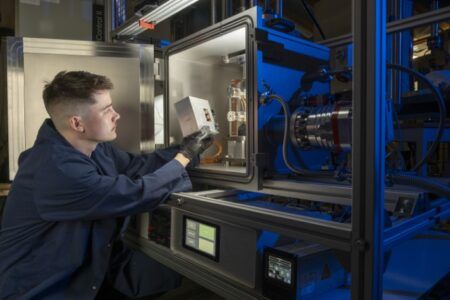Researchers from MIT in the USA have developed a manufacturing process suitable for large composite aircraft parts that removes the need to use large ovens and autoclaves for curing.
The technique, which uses pressure-generating carbon nanotube films could significantly speed up and reduce the cost of manufacturing structural aircraft parts such as fuselages and wings. The results of the five-year research project were published in the journal Advanced Materials Interfaces this week.
Brian Wardle, professor of aeronautics and astronautics at MIT said, “Now we can make primary structure materials without autoclave pressure, so we can get rid of all pressure vessels and autoclaves, which themselves require time and money to pressurize.”
Instead of placing layers of material inside an oven to cure, the researchers wrapped them in an ultrathin film of carbon nanotubes (CNTs). When an electric current was applied to the film, the CNTs, like a nanoscale electric blanket, quickly generate heat, causing the materials within to cure and fuse together.
The out-of-oven (OoO) technique developed by the research team was shown to be capable of producing composites as strong as the materials made in conventional airplane manufacturing ovens, while only using 1% of the energy.
Out-of-autoclave processes
The researchers next looked for ways to make high-performance composites without the use of large, high-pressure autoclaves “There’s microscopic surface roughness on each ply of a material, and when you put two plys together, air gets trapped between the rough areas, which is the primary source of voids and weakness in a composite,” Wardle said. “An autoclave can push those voids to the edges and get rid of them.”
Efforts so far to develop out-of-autoclave (OoA) composite manufacturing techniques have resulted in composites where around 1% of the material produced contains voids. This 1% can compromise a material’s strength and lifetime, whereas aerospace-grade composites made in autoclaves contain such a small amount of voids it is difficult to measure them.
Wardle said, “The problem with OoA approaches is also that the materials have been specially formulated, and none are qualified for primary structures such as wings and fuselages. They’re making some inroads in secondary structures, such as flaps and doors, but they still get voids.”
Nanotube film avoids voids
The MIT researchers laid the ultrathin carbon nanotube film between layers of materials that are typically used in the autoclave-based manufacturing of primary aircraft structures. They wrapped the layers in a second film of carbon nanotubes and applied an electric current to to heat it up.
As the materials heated and softened in response, they were pulled by the intermediate CNT film. The resulting composite lacked voids, similar to aerospace-grade composites that are produced in an autoclave.
The researchers subjected the composites to strength tests, attempting to push the layers apart, the idea being that voids, if present, would allow the layers to separate more easily.
“In these tests, we found that our out-of-autoclave composite was just as strong as the gold-standard autoclave process composite used for primary aerospace structures,” Wardle said.
Next steps
The team is now looking for ways to scale up production of the pressure-generating CNT film to make the CNT and nanoporous film processes viable for manufacturing entire wings and fuselages. “We have a new material solution that can provide on-demand pressure where you need it,” Wardle added. “Beyond airplanes, most of the composite production in the world is composite pipes, for water, gas, oil, all the things that go in and out of our lives.
“This could make making all those things, without the oven and autoclave infrastructure.”
This research was supported in part by Airbus, ANSYS, Embraer, Lockheed Martin, Saab AB, Saertex, and Teijin Carbon America through MIT’s Nano-Engineered Composite aerospace Structures (NECST) Consortium.





